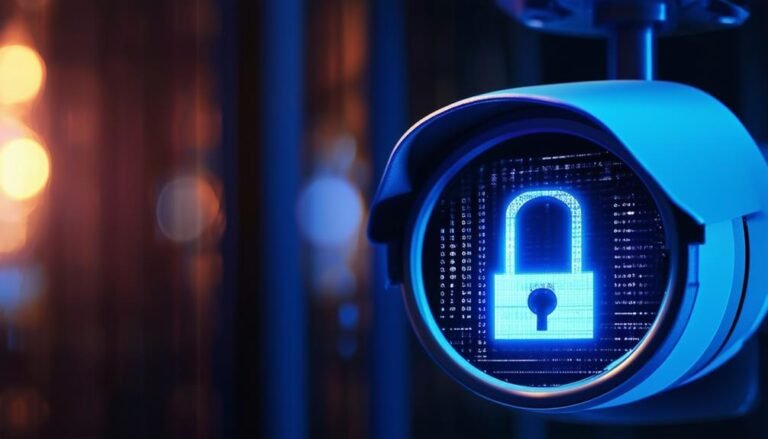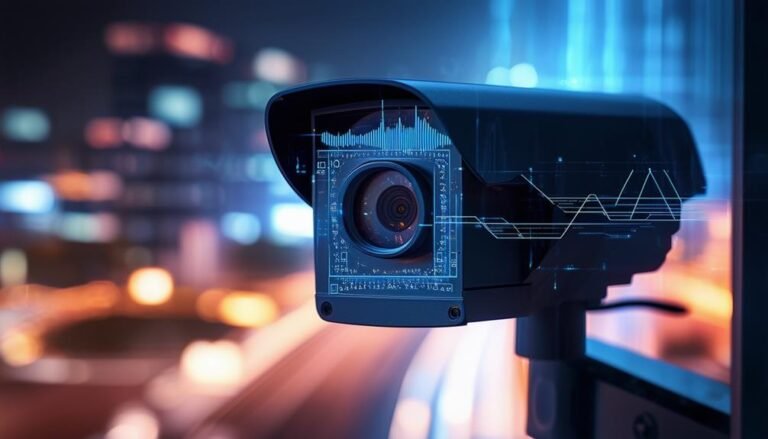If you can’t find your Dahua camera on the network, start by checking the power and connections. Confirm the camera is powered and the Ethernet cable is securely attached to both the camera and router. Next, verify the camera’s IP settings; it should match your local network’s subnet. Utilizing the Dahua Config Tool can simplify device discovery. If all else fails, try resetting the camera to factory settings and checking your firewall settings to verify nothing’s blocking the camera’s connection. There’s more to explore to solve this issue effectively, so keep digging for solutions!
Check Camera Power Status
Before diving into troubleshooting your Dahua camera, it’s important to verify it’s powered on. You can’t connect to something that’s not alive, right? Start by checking the power source. Confirm that the power cable is securely plugged into both the camera and the wall outlet. If the camera uses PoE (Power over Ethernet), check that the Ethernet cable is connected to a PoE switch or injector that’s functioning correctly.
Next, look for any indicator lights on the camera. A solid green light typically means it’s powered and ready for action, while a blinking light might indicate it’s booting up. If there’s no light at all, you might have a power issue. Consider switching outlets to see if the problem lies with the original one.
If you’ve got a multi-camera setup, you could try swapping the power adapter with one from a working camera. This way, you can quickly identify whether the power supply is the issue or if your camera itself is the culprit.
Don’t forget about the basics—make sure the power outlet is functional. Plug in another device to verify it’s working.
Once you’ve confirmed that your camera is indeed powered on, you can move on to the next steps in troubleshooting. It’s all about making sure you’ve got a solid foundation before you start digging deeper. After all, freedom in surveillance begins with a reliable connection.
Verify Network Connection
After confirming your Dahua camera is powered on, the next step is to verify its network connection. A stable connection is essential for your camera to communicate effectively with your network. Here’s how you can verify it’s connected properly:
- Check Ethernet Cable: If you’re using a wired connection, make sure the Ethernet cable is securely plugged into both the camera and the router.
- Inspect Wi-Fi Signal: For wireless setups, check if the camera is within range of the Wi-Fi signal. Walls and obstructions can weaken the connection.
- Router Settings: Access your router’s settings to see if the camera is listed among connected devices. This can help you confirm that it’s recognized on the network.
- Power Cycle Devices: Sometimes, simply rebooting both the camera and the router can resolve connectivity issues, so don’t hesitate to give it a try.
You’ve got the right to enjoy a seamless experience with your Dahua camera, and verifying its network connection is an important step. If these checks don’t resolve your issue, don’t lose hope! There are plenty of avenues to explore, and troubleshooting is part of the journey toward achieving that sense of freedom in monitoring your space. Stay patient, keep experimenting, and you’ll get there. Remember, technology is meant to empower you, and with a little perseverance, you’ll find your camera back on the network in no time.
Examine IP Address Settings
When you’re having trouble finding your Dahua camera, checking the IP address settings is essential. Make sure to confirm the default IP address, verify the subnet mask, and analyze the DHCP settings. These steps can help you pinpoint the issue and get your camera connected properly.
Check Default IP Address
To successfully connect your Dahua camera to the network, it’s crucial to check its default IP address settings. This step guarantees that your camera can communicate with your network and allows you to access its features freely. Here’s how to get started:
- Find the default IP address: Most Dahua cameras come with a standard default IP address. You can usually find this in the user manual or on the manufacturer’s website.
- Connect directly: Temporarily connect your camera directly to your router or computer using an Ethernet cable to simplify the process.
- Access the camera: Use a web browser to enter the default IP address. This should bring up the camera’s login interface, giving you a chance to explore its settings.
- Change settings if necessary: If the default IP address doesn’t work, you may need to set a compatible IP in your computer’s network settings.
Verify Subnet Mask
Verifying the subnet mask is essential for ensuring that your Dahua camera can communicate properly with your network. If your camera’s subnet mask doesn’t match the one used by your local network, it won’t be able to send or receive data effectively. So, let’s take a moment to check that.
First, access the network settings on your camera using its web interface or configuration tool. Look for the IP address and subnet mask settings. You want to make sure that the subnet mask is the same as the one your router is using. Typically, for home networks, it’s set to 255.255.255.0, but yours might differ if you’ve customized your network.
Next, check your computer’s network settings. On Windows, you can open the command prompt and type “ipconfig” to find your subnet mask. If they don’t match, you’ll need to adjust the camera’s settings so that they align.
Once the subnet mask is verified and corrected, you should find that your Dahua camera can now be detected on the network. This small step can make a big difference in ensuring seamless connectivity.
Analyze DHCP Settings
Analyzing the DHCP settings is essential for guaranteeing your Dahua camera receives a proper IP address from your router. If your camera isn’t appearing on the network, the DHCP configuration might be the culprit. Here’s what you need to check:
- DHCP Enabled: Make sure DHCP is activated on your router.
- IP Address Range: Confirm that the range of IP addresses provided by the router includes the camera’s.
- Lease Time: Look at the lease time settings; shorter lease times may cause disruptions.
- Conflict Resolution: Verify there are no IP address conflicts with other devices on your network.
If DHCP isn’t working as it should, your camera won’t find its way onto the network. You might consider assigning a static IP address to your Dahua camera as a temporary solution. This method can provide immediate access while you resolve DHCP issues. By keeping an eye on these settings, you’ll gain greater control over your network setup and guarantee your camera operates freely and efficiently. Remember, a properly configured DHCP can notably enhance your surveillance experience and give you peace of mind.
Use Dahua Config Tool
To get your Dahua camera connected, you’ll want to start by downloading the Dahua Config Tool. This handy software helps you scan for devices on your network and adjust any necessary network settings. With just a few clicks, you can troubleshoot and hopefully resolve your connectivity issues.
Downloading the Config Tool
Downloading the Dahua Config Tool is essential for finding and managing your Dahua camera on the network. This tool simplifies the process of locating your camera, ensuring you have complete control over your surveillance system. It’s a straightforward download that can save you time and frustration.
Here’s what you’ll gain by using the Dahua Config Tool:
- Easy Camera Discovery: Quickly find all Dahua cameras connected to your network.
- User-Friendly Interface: Navigate effortlessly through the intuitive design.
- Configuration Options: Adjust settings to optimize your camera’s performance.
- Firmware Updates: Keep your devices up-to-date for enhanced security and features.
To start, head over to the official Dahua website and locate the Config Tool under the downloads section. Once you’ve downloaded it, follow the installation prompts, and you’re ready to embark on managing your camera. With this tool, you’ll break free from the hassle of manual configurations and enjoy a seamless experience in monitoring your space. Embrace the freedom and security that comes with effective surveillance management, and don’t let technology hold you back.
Scanning for Devices
Once you’ve installed the Dahua Config Tool, scanning for devices on your network becomes a breeze. Launch the tool, and you’ll see a user-friendly interface that invites you to explore your network’s landscape. Click on the “Search” button, and the tool will begin scanning your local network for any Dahua devices. It only takes a couple of moments, and you’ll be presented with a list of cameras and recorders that have been detected.
If you’re keen to regain control over your surveillance setup, this step is essential. Make certain your computer is connected to the same network as your Dahua cameras. Otherwise, they won’t show up.
If your devices don’t appear, double-check your connections and verify the cameras are powered on. Sometimes, a simple reboot can work wonders. Once your devices are found, you can start configuring them to suit your needs, giving you the freedom to monitor your space as you see fit. So, go ahead and take that first step with the Dahua Config Tool—it’s your gateway to a seamless surveillance experience!
Adjusting Network Settings
After successfully scanning for your Dahua devices, the next step is adjusting their network settings to confirm they function most effectively within your network. You want your cameras to communicate seamlessly and provide you with the freedom to monitor your space without interruptions. By using the Dahua Config Tool, you’ll have the control you need.
Here are some key adjustments you might consider:
- IP Address Configuration: Confirm each device has a unique IP address to avoid conflicts.
- Subnet Mask and Gateway: Set these correctly to enable proper communication with your router.
- DNS Settings: Adjust DNS settings for reliable domain name resolution.
- Network Protocols: Choose the right protocols that suit your network’s architecture.
Getting these settings right will empower you to experience the full capabilities of your Dahua cameras. Take your time to confirm everything’s configured properly; it’s essential for maintaining a smooth connection. With just a few adjustments, you can enjoy the freedom of surveillance that fits your lifestyle. So, embrace the technology and make it work for you!
Reset Camera to Factory Settings
When you can’t find your Dahua camera on the network, resetting it to factory settings can often resolve the issue. This process wipes any old configurations, allowing you to start fresh. Here’s how you can do it:
- Locate the reset button on your camera. It’s typically a small pinhole button.
- Use a pointed object, like a paperclip, to press and hold the reset button for about 10-15 seconds.
- Once the camera’s LED indicator starts flashing, you can release the button. Your camera will reboot and reset to factory defaults.
After resetting, you’ll need to reconnect it to your network. Here’s a handy table to guide you through the reset process:
| Step | Action | Note |
|---|---|---|
| Locate the button | Find the reset button on the camera | Usually a pinhole button |
| Press and hold | Use a paperclip to hold for 10-15s | Wait for LED to flash |
| Release the button | Let go once the indicator flashes | Camera will reboot |
| Reconfigure settings | Access the camera via its default IP | Re-enter Wi-Fi info |
| Test connection | Check if the camera is now online | Confirm through the app |
Once you’ve reset the camera, you should be able to find it on your network again. Embrace the freedom of a fresh start!
Check Firewall and Security Settings
Check your firewall and security settings to confirm your Dahua camera can communicate with your network. If you’re having trouble finding your camera, these settings might be blocking its connection. Your camera needs a clear path to send and receive data, and firewalls can sometimes throw up barriers.
Here are some key points to keep in mind:
- Check Firewall Rules: Verify your firewall isn’t set to block the camera’s IP address or the ports it uses.
- Disable Unnecessary Security Features: Temporarily disable any overly aggressive security features that could be hindering the connection.
- Network Isolation Settings: If you’re using a router with isolation settings, make sure your camera isn’t isolated from the rest of your network.
- Protocol Compatibility: Confirm that the security protocols (like WPA2) on your network are compatible with your camera’s requirements.
It’s all about confirming your camera isn’t being held back by overly restrictive settings. You want your Dahua camera to roam free and connect seamlessly to your network. Once you’ve adjusted these settings, try searching for the camera again. If it still doesn’t show up, you may need to explore deeper into your router settings or consider other factors like network congestion. Embrace the freedom of a well-connected device, and take control of your security setup!
Update Camera Firmware
If you’re still unable to locate your Dahua camera on the network, updating its firmware might be the next step. Firmware updates often bring enhancements, fixes, and improved compatibility with your network, so it’s worth checking. Here’s how to go about it:
- Download the Firmware: Visit the official Dahua website or the support page for your specific camera model. Make sure you’re downloading the correct firmware version.
- Access the Camera Interface: Open your web browser and enter the camera’s IP address. Log in with your credentials.
- Navigate to the Upgrade Section: Look for the “Firmware Upgrade” or “System” tab in the settings menu.
- Upload the New Firmware: Select the downloaded firmware file and initiate the update. Don’t interrupt the process; this could brick your camera.
- Reboot and Reconnect: Once the update completes, reboot the camera and check if it’s discoverable on your network.
Here’s a quick reference table for your convenience:
| Step | Action |
|---|---|
| 1. Download Firmware | Visit Dahua’s official website |
| 2. Access Camera Interface | Input the camera’s IP in your browser |
| 3. Navigate to Upgrade | Find the firmware upgrade section |
| 4. Upload and Reboot | Select file, update, and restart the camera |
Consult Technical Support
Sometimes, even after following all troubleshooting steps, your Dahua camera might still be elusive on the network. If that’s the case, it might be time to reach out to technical support. Don’t worry; you’re not alone in this. Technical support can provide the expertise you need to get your camera up and running. Here’s what you can expect when you consult them:
- Expert Guidance: Tech support agents are trained to handle various issues and can provide tailored solutions for your situation.
- Troubleshooting Assistance: They can guide you through advanced troubleshooting steps that you might not have considered.
- Firmware Updates: If there’s a hidden firmware issue, they can help you ascertain your camera is updated correctly.
- Network Configuration Help: They can assist you in checking your network settings and configurations to ascertain everything’s set up properly.
Don’t hesitate to reach out. When you contact technical support, make sure you have all relevant information handy—like your camera model, network details, and any error messages you’ve encountered. This will help them assist you more effectively. Remember, sometimes it takes a little extra help to reclaim that freedom and peace of mind you’re looking for. Your Dahua camera deserves to shine on your network, and the support team is there to make it happen.
Frequently Asked Questions
How Can I Locate the Camera’s Serial Number?
To locate your camera’s serial number, start by checking the camera itself; it’s often printed on a label. You can also explore the device’s settings through its web interface; the serial number might be listed there. If you’ve got the original packaging, look for documentation that includes the serial number. Remember, finding this number is about reclaiming control and knowing your device inside and out, ensuring your freedom in managing your technology.
What Does the Camera’s LED Indicator Signify?
The camera’s LED indicator can tell you a lot about its status. If it’s solid green, your camera’s powered and connected properly. A blinking green often means it’s starting up or recognizing a connection. If you see red, it usually indicates a problem, like a connection failure. Understanding these signals can help you troubleshoot issues quickly, giving you more freedom to enjoy your security setup without unnecessary stress.
Can I Connect Multiple Cameras to One Network?
Yes, you can connect multiple cameras to one network! It’s a great way to expand your surveillance coverage. Just confirm your network can handle the additional bandwidth and that each camera has a unique IP address. You might need a compatible network switch or router, depending on how many cameras you want to add. Once everything’s set up, you’ll enjoy seamless monitoring and increased security without feeling restricted.
Are Dahua Cameras Compatible With Third-Party Software?
When you think about endless possibilities, compatibility with third-party software is essential for your Dahua cameras. Yes, they’re often compatible with various software platforms, giving you the freedom to customize your surveillance experience. You’ll find that many users successfully integrate Dahua cameras with popular video management systems. Just verify you check the specific software’s compatibility to maximize functionality and get the most out of your investment. The options are yours to explore!
What Are the Recommended Network Settings for Optimal Performance?
For ideal performance, you should set your Dahua camera’s IP address to a static one within your network’s range, avoiding conflicts. Confirm the subnet mask matches your network—typically 255.255.255.0. Use a DHCP server for easy management, but don’t rely on it for critical devices. Verify the camera’s firmware is updated to the latest version for security and performance. Finally, consider enabling PoE if your setup supports it for simpler cabling.



